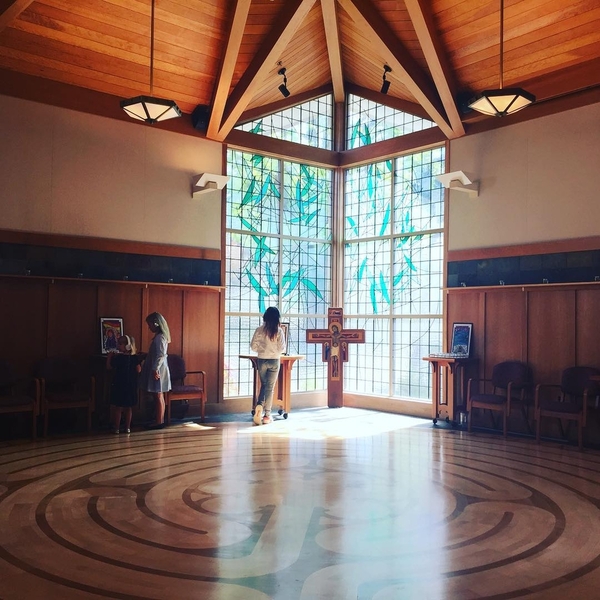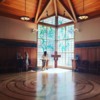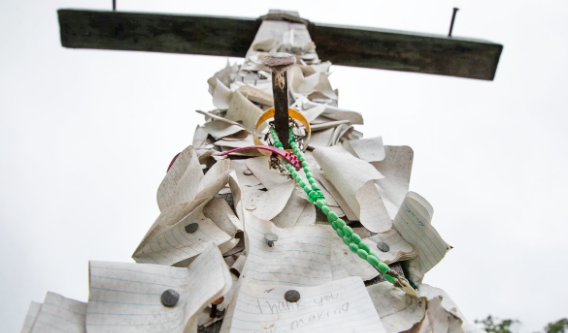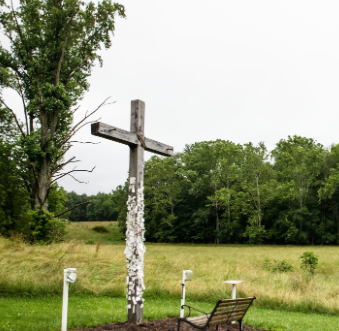Art Stations
Originally posted by longtime member, Sheila B.
Art Study of Stations of the Cross
A Lenten Art Study (Intergenerational) on the Stations of the Cross
by member SheilaB
(subsequently published in Sheila's Diocesan newsletter!)
Background:
The Stations of the Cross depict 14 events in the last day of Jesus' life. Some churches also use a 15th station of the Arisen Christ. Churches often do a Stations of the Cross service on Good Friday but some religious orders use the Stations for regular meditation. I was looking for a way to bring the adults and children together and I created an art study on the Stations of the Cross that we used as a Lenten Intergenerational Study. This could be done at any time and having more time to spend on each piece could be beneficial. We started the evening with a simple soup, salad and bread supper and during dinner did a brief study on the stations we were focusing on that evening. After supper, people chose the station they wanted to work on and we had parish artists to act as their guides. Our "resident artists" were between 10 and 80 years old. Each team was given a medium to work with and they had to create an artistic reflection on their station. Some are depictions, others representational. Your art will not look like our art, nor should it. Your artists may choose different mediums and your artists may see something different in each station. I will describe each of our stations, tell you the medium used and why if I know. Next year we will do a study where we will write meditations for each piece of art. We used ours for an intergenerational Stations of the Cross Service where we used more understandable and shorter readings on each station than are used in the Book of Occasional Services.
The first thing I did was take stock of all the artists in our parish and this includes children. Don't overlook any kind of art. Some forms that we did not use were painting, calligraphy, photography and stained glass just to name a few. Then I listed as many kinds of mediums as I could think would be possible in 1 1/2 hours. If I used a professional artist I let them chose the medium and it was usually the one they worked with most. If it were someone that was just artistically talented, I showed them my list and asked in which they would like to work. I tried not to duplicate a medium to give the most variety of art.
We then met as a team and brainstormed on how to incorporate 3yr olds to 80 year olds and still have art. Not every piece was child friendly but we made sure that at least one each night was and we also made garden stepping stones with concrete and mosaic stone, marbles and rock and my youngest children designed almost all of these. The artist supplied the material and had at least an idea or two to suggest in case his team came up with nothing on their own. Each piece was a group effort.
We are doing this for 5 weeks and with the exception of the first week, we are studying 3 stations each week. Our first week we studied 2 and had 37 people show up on Valentines day for the study. That is almost double the number that have ever come to a Lenten Study before. I expect the number to grow as word gets out.
We have also added an earlier daylight Stations Walk that will be outside (weather permitting, inside the parish hall if it rains) around our church and each station will be spaced enough away from the others that everyone can gather and meditate on the station being taught. It will be a beautiful art show and by people making the stations, they take a vested interest in the walk.
I have to say, it is the best thing I have done since I started Rotation and it gives the adults a little taste of Rotation type activities.
Station 1: Jesus is Condemned
Medium: Origami
Folding patterns were found in books and on the internet to create as many people as we could. The 14-year-old artist had folded origami for years and with the help of several of our church women, they managed to fold enough to create this scene which we put together on a foam board with anchor sticks to hold up the figures.
Also, put "The Simple Sorcerer" by Perry Bailey in a search engine as well as "The Belle Damsel" by Perry Bailey and you should come up with public domain patterns for these as well.
Station 2: Jesus takes up his cross
Medium: Wood
The artists decided to make a cross of crosses. These were mostly all of the young boys of our parish, they drew it out and the resident artist, a woodworker, helped them cut it out with jig saws. Then it was sanded and stained and attached together to form the cross. This was designed to be an outside piece as we originally had planned to have the stations around the outside but rain changed those plans.
Station 3: Jesus falls the first time
Medium: cloth doll and other items
Using a cloth bendable doll, some felt and other items the artists created Jesus falling with his cross. These were hot glued to the board for permanence.
Station 4: Jesus meets his mother
Medium: clay
The artists created people from the story out of fireable clay. The clay however has not been fired but it is an option that can happen in the future. Presently they are glued on their base.
Station 5: The cross is laid on Simon of Cyrene
Medium: Nylon
The artists created a banner by cutting the nylon with wood burning tools so it would not shred and adhering the pieces to a white nylon banner with hot dots from the tools. The artist later took it home and stitched it together for more permanence. This project took 2 nights to make. She used rolled steel laid out flat under the nylon to burn on and melt the nylon.
Station 6: A woman wipes the face of Jesus
Medium: Cloth and water color paint
The artists had to pair off. One person laid a piece of cotton cloth over their face and the artist spritzed the cloth with water and then using water color paint, painted over the actual features on the face to create eyebrows, eyes, nose and mouth. It is said that the image of Jesus' face was on the cloth after he wiped it.
Station 7: Jesus falls a second time
Medium: Foam and pins and cloves
This is more of a reflection art. The cross is tipped in a fall and there are items falling off. Sequins and pins and cloves were used to create designs in the foam.
Station 8: Jesus meets the women of Jerusalem
Medium: Paper relief masks
These are the faces of the artist and 4 young boys. This is created with paper sacks and white glue and water. The paper is torn and actually glued over the face to take on the shape of the face. Each person makes his own but the boys did have some help with the layers to make them smoother. First a strip is fastened around the chin and top of the head and pieces are attached here and then layers are added on top and smoothed with more glue water. The cloth coverings were added to create the illusion of women. They are cloth dipped in liquid starch.
Station 9: Jesus falls a third time
Medium: Wire and wood
This is a wire sculpture. Lengths of wire are twisted to form people and they are nailed to the board and formed into a scene.
Station 10: Jesus is stripped of his clothes
Medium: Cloth, starch and wood
This was actually done mostly by a 4 year old and a 6 year old pair of sisters. A cross was nailed together to form a hanger of sorts. Then two square pieces of cloth were folded and cut in the middle to hang over the cross. The artists then cut and ripped the cloths and then soaked them in liquid starch and arranged them to dry. When dry they are stiff.
Station 11: Jesus is nailed to the cross
Medium: Wood and square nails
A cross outline was made in the wood by hammering in nails. The figure of Jesus was drawn and a nail crown of thorns was added with other details.
Station 12: Jesus dies on the cross
Medium: Found items
The cross was previously made for station tableau pictures taken 3 years ago. The artists created a life-size Jesus out of found items (formerly called junk, but real artists call them found items, so we call him found Jesus). When my son, the resident artist for this medium, told me his idea, I was skeptical. A professional artist, told me not to squelch his creativity. I asked him why and he said because Jesus was treated like throwaway junk during this time and he wanted to make him out of Junk. We called him Junk Jesus at home but Found Jesus is so much better. Think about it, Jesus was just expendable trash. By making him out of our throw away items it shows that Jesus is found in everything we do.
Station 13: Jesus is laid in the arms of his mother
Medium: Paper Mache
The base was created with foil and balloons and then covered with paper mache. Lesson learned, if you are using paper mache put plastic under the table and at a large diameter as well because little kids shake it everywhere. This was a favorite of our young set. After it dried it was painted and hair was added.
Station 14: Jesus is laid in the tomb
Medium: Ukrainian Easter Eggs
This is art done with wax and dye and eggs. We blew out the eggs and then draw with a special wax tool melted in a flame lines and symbols that you want to stay white then you dye it the lightest color (yellow) then you add more wax to areas you want to stay yellow and dye a darker color. Repeat this process until you have all of the colors you want. Then I find it easiest to heat in a 200 or so degree oven and wipe off the wax until it is all gone. Some people lightly melt it near the candle and wipe but I always burn my egg. When done, varnish them and then we glued them together to form a tomb, as our priest called it an "eggloo" we then added a small shroud wrapped around a body shape. Unfortunately, I don't have a picture of the original artwork and in the move to the permanent display my son accidentally dropped the sculpture and it broke. We are in the process of making a new one.
We hope to use these for several years. It may be necessary to recommission separate pieces much like the egg tomb as accidents and time happen. In the first 3 weeks of this 5 weeks study, we had over 40 people each night the last 2 weeks as time got busier we had about 20 people each night. Our artists ranged from age 4 to age 80+.
For each of the 14 stations, we are also making a stepping stone with a mosaic scene, this is proving very popular with my younger artists. The stepping stones are now proudly placed in a meditative walk in our side garden.
Also available are quilt squares and fabric markers so they can draw the station and these will be made into a hanging for each station.
Sheila
 The Rotation.org Writing Team has written a "Stations of the Cross" lesson plan. If you're a Supporting Members, be sure to check it out.
The Rotation.org Writing Team has written a "Stations of the Cross" lesson plan. If you're a Supporting Members, be sure to check it out.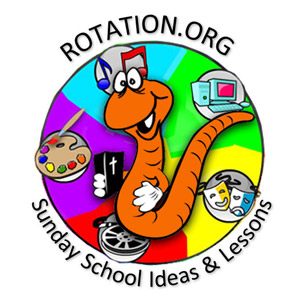
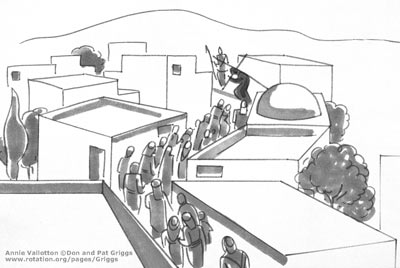

 We have a Lent program that is geared towards the whole church and a "Palm Saturday" event that is more for the kids.
We have a Lent program that is geared towards the whole church and a "Palm Saturday" event that is more for the kids.


